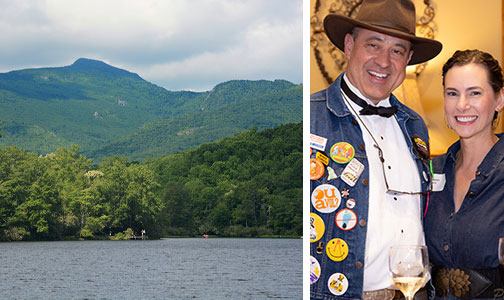Nature & Outdoors

Grandfather Mountain from Price Lake, photo by Andy Massengill; Denim Ball, photo by Lonnie Webster
Nature Notes: Enjoy Spring on the Parkway
By Rita Larkin
The flowers are blooming, the birds are singing, and spring is ready to showcase enchanting outdoor adventures on the Blue Ridge Parkway. Whether you head north or south on the scenic route, you’ll find great destinations, but here we are sharing just a few High Country favorites to kick off a season of exploration.
For the Bird(ers)
Grab your binoculars and roam the fields and forests of Moses H. Cone Memorial Park, milepost 294, to spot a great variety of birds, including waterfowl and songbirds at Bass and Trout lakes during their spring migration. In days gone by, Bertha Cone and her sisters also enjoyed birding on the 3,500-acre estate, which is now listed on the North Carolina Birding Trail. Each new season brings visits from new flighted friends, including Blue-headed Vireos, Scarlet Tanagers, Sharp-shinned Hawks, and Belted Kingfishers.
This spring, the estate will become even more welcoming to birders as the Bass Lake Loop Trail, a gravel path just short of a mile, will undergo improvements to become more accessible for those with disabilities thanks to support from Blue Ridge Parkway Foundation donors.
KaBloom!
Autumn may receive overwhelming accolades for painting the mountains with golden hues, but spring on the Parkway is arguably just as eye-popping with its vibrant native blooms. Pick any trail in the national park to find wildflowers that wow, from the sunny buttercup to purple crested dwarf iris to the flame red fire pink. Just remember to leave the blooms behind so as not to diminish the flower show for others or harm a rare plant. However, you can share your discoveries with scientists from around the globe by taking photographs and uploading the images to iNaturalist.org.
Back in the Saddle
Riding the carriage trails on horseback in the crisp mountain air is an exhilarating way to embrace spring at the Cone estate. Riders can load and unload horses at the pull-offs on U.S. 221 near Bass Lake or at the Trout Lake parking area. For a custom guided experience on the carriage trails, book a ride with Tim Vines of VX3 Trail Rides (vx3trailrides.com).
Lake Life
Make Julian Price Park and its namesake lake a spring getaway. Opening in April, this recreation area’s campground is the first to welcome overnight guests on the Parkway each year. You can cast a line from the shore or explore the 47-acre lake by canoe, kayak, or paddleboard with a vessel from Price Lake Boat Rentals, milepost 297. To stretch your legs, trek the lake’s loop trail or a section of the nearby Mountains-to-Sea or Tanawha trails.
The Denim Ball
Be sure to mark your calendar for The Denim Ball on Thursday, September 5. The seventh annual fundraiser for Moses H. Cone Memorial Park will be hosted by Camp Yonahnoka at Linville Golf Club. For more information and the ticket release date, visit BRPFoundation.org.

